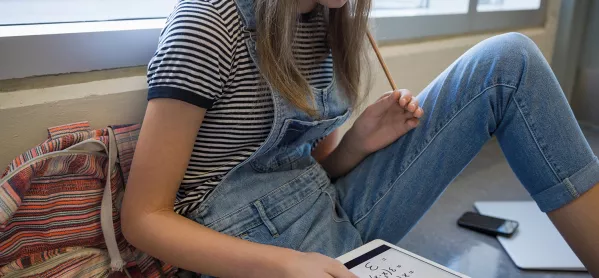- Home
- The potential of iPads in maths? The limit does not exist...
The potential of iPads in maths? The limit does not exist...

It was a situation maths teachers across the country will recognise: I was in the middle of a lesson about graph transformations with a top set GCSE class, they were on board with the ideas and most were beginning to “get it”, when a pupil put their hand up…“Sorry, but I just can’t picture that - what does that look like?”
Now, in days gone by, I would have brought their attention to some more of the diagrams I had prepared. If I was lucky enough to have a computer and projector in my classroom, I would have logged on - once the system got up to speed - and brought up something visual for them to see, but on this occasion things were different.
“No problem,” I said, “could everyone open their iPads and go to Desmos [a graphing app].”
From there, the students were able to look at their own graphs, put in their own functions and see what happened. They could investigate and learn at a pace that suited each of them individually.
This situation is not a one-off. Solutions such as this are happening in maths lessons in schools that have adopted a 1:1 tablet or similar approach to learning. You don’t need to wait when a student asks a curveball question, or when, despite the number of different ways you have planned to explain something, a student needs one more option. The technology is there to help.
When calculators came into existence, they brought an end to spending excessive amounts of time on the calculation side of the work, so students could focus on the techniques. iPads have revolutionised the classroom again, bringing the resources of the outside world straight to the student’s hand.
I know that I am lucky. Two years ago, my school took a step into the brave new world of Bring Your Own Defined Device (BYODD) teaching, I live and work in a part of the country where students can bring their own device to school without worry and the students and parents have bought into this.
But I do think we need to push for all schools to have this opportunity.
Don’t hate, calculate
I know there will be those against such a move. The same occurred with calculators. Initially, it was felt that limits should be put on who should be allowed to use calculators in class, so as not to hamper the ability to calculate.
However, those limitations were soon removed, as it was quickly appreciated that even if they weren’t used in the classroom, they would be outside of it. Despite this, the staff in those few schools that took that early plunge must have felt trepidation about leading the way and excitement about how this might change what they did.
But calculators soon became the norm for students and the rest, as they say, is history.
And iPads - other devices are, of course, available - will, I feel, have a similar impact. For now, there is fear of how they should be used and of what impact that will have on learning. “Will the students concentrate?”, “Will it reduce their ability to work things out?”
It would be wrong of me to say that everything has been plain sailing and that there are no potential downsides.
Instant access to education brings with it instant access to distraction. For every student and teacher who is fully on board, there will be those who are more technophobic. Like every change, the repercussions need to be thought through.
Training needs to be available. Guidance needs to be given to staff, students and parents. Processes and procedures need to be adapted to ensure the safety both of the students and the teachers - but the benefits could be huge.
What’s your vector, Victor?
Now students can instantly watch YouTube clips of planes landing in crosswinds when they ask about vectors, they can slo-mo film bouncing objects when looking at coefficients of restitution and they can carry around all of their textbooks digitally without the need for a bag that weighs as much as a small elephant - although I’m sure I was told that was character building when I was their age...
They can record video and take photos to understand or support a particular learning style and they can access the same material at home as in the classroom. Programs such as OneNote and Google Classroom have completely changed the way students can access and use material, creating a virtual learning environment that works for them.
The pros far outweigh the cons.
As with the calculator, it will take time before the world catches up with technology. Cost is currently an issue - if the requirement is for a tablet. If we can take that interim step of allowing students to use their smartphones instead, then for most that problem is solved. We must not forget that smartphones such as the iPhone have been available for little more than a decade. Now we have students who own smartwatches with this capability on their wrist. How long can it be before it is available to all?
I believe this technology gives students the best access to education, builds links between the subject and reality and helps me develop their understanding. Not only will they achieve while at school, but also be better prepared for the modern world.
Anthony McAleese is assistant head at The Mount School, York
Keep reading for just £1 per month
You've reached your limit of free articles this month. Subscribe for £1 per month for three months and get:
- Unlimited access to all Tes magazine content
- Exclusive subscriber-only stories
- Award-winning email newsletters
